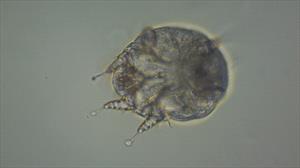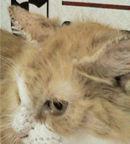Notoedres cati, Cat (Microphotograph)

Notoedres cati mite found on cat pinna.
Courtesy Dr. Brad Cahoon
Notoedric mange is the scabby, scaly skin disease resulting from feline mite Notoedres cati infection. Notoedres mites are closely related to sarcoptic mange mites of dogs, and thus, the two infections have some similarities. Both conditions typically begin with itchy crusts and scales on the ear margins. Notoedric mange progresses to involve the face, and ultimately, if the skin disease is ignored, it will cover the cat’s entire body. The term scabies is somewhat colloquial and refers to a mite infection with any of the mites in Sarcoptidae family. Many veterinary dermatologists never see this condition in their entire careers; in the United States, notoedric mange is considered rare, with regional hotbeds of infection.
How is the Diagnosis Confirmed?
A scraping of the crusty skin can be examined under the microscope. Mites and/or their eggs are generally not difficult to detect if they are present; their absence does not rule out notoedric mange. Sometimes, a trial course of treatment is needed to fully rule out the infection. The mite is highly inflammatory, hence the intense itching.
Consider that when one cat at home is diagnosed with this condition, all cats at that home may require treatment.

An example of classic Notoedric Mange symptoms. Courtesy Dr. Wendy Brooks
Can the Infection be Transmitted to Other Pets or to Humans?
Yes, it can. Notoedres mites are spread by touch, and they can certainly infect humans, dogs, or rabbits. They do not live off their host for more than a few days at best, thus transmission is generally by direct contact with an infected individual.
Treatment
There are several options for the treatment of this condition.
Isoxazoline Class Flea Control Products
At present, there are three products labeled for feline use: Fluralaner (Bravecto®), lotilaner (Credelio®), and sarolaner (Revolution Plus®). These medications are the newest insecticides for cats and have become popular for killing fleas and ticks, but they are also effective against mites such as Notoedres cati. None of these products is actually approved for use against Notoedres cati; because of the rarity of Notoedres it is unlikely that any company will pursue official approval. A single dose should be effective, and regular use of these products for flea control should be preventive.
Selamectin (Revolution® and Revolution Plus®)
This topical medication was designed for flea, heartworm, and intestinal parasite control. In dogs, it is approved for control of sarcoptic mange mites but due to the rarity of Notoedres cati, as noted above, the manufacturer is unlikely to pursue the expensive process of gaining FDA approval for Notoedric mange. Still, selamectin, is effective against Notoedres cati and regular use of it for flea control seems to be preventive.
Moxidectin (Advantage Multi® and similar brands)
This product is another monthly topical flea preventive similar to the others listed. As with the others, regular use is preventive. Advantage Multi is used against fleas, ear mites, heartworms, roundworms, and hookworms.
Ivermectin
Usually given as an injection, this medication was one of the first treatments used against Notoedres cati. It is still used today. Treatment is typically weekly or every two weeks for a month, and recovery is prompt. Doses approved for heartworm prevention in cats are not high enough to treat Notoedric mange; different dosing is needed.
Dipping
In the past, a series of six or seven lime-sulfur baths or amitraz dips were used to control this infection. While this certainly works, the cat’s general dislike of bathing created a need for something more convenient. Furthermore, lime sulfur has an extremely objectionable smell and will discolor fur. Amitraz tends to produce sedation in some patients and headaches in some humans. Not surprisingly, this method is rarely used nowadays.
This is Pete before and after he was treated with one dose of ivermectin.
Nose Before Treatment

Courtesy Dr. Wendy Brooks
|
Nose After Treatment

Courtesy Dr. Wendy Brooks
|
Ears Before Treatment

Courtesy Dr. Wendy Brooks
|
Ears After Treatment

Courtesy Dr. Wendy Brooks
|
Face Before Treatment

Courtesy Dr. Wendy Brooks
|
Face After Treatment

Courtesy Dr. Wendy Brooks
|